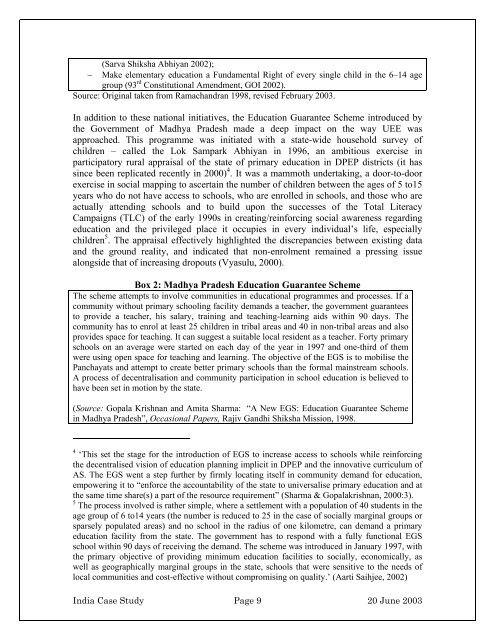Where are we today with respect to girls' education
Where are we today with respect to girls' education
Where are we today with respect to girls' education
- No tags were found...
You also want an ePaper? Increase the reach of your titles
YUMPU automatically turns print PDFs into web optimized ePapers that Google loves.
(Sarva Shiksha Abhiyan 2002);− Make elementary <strong>education</strong> a Fundamental Right of every single child in the 6–14 agegroup (93 rd Constitutional Amendment, GOI 2002).Source: Original taken from Ramachandran 1998, revised February 2003.In addition <strong>to</strong> these national initiatives, the Education Guarantee Scheme introduced bythe Government of Madhya Pradesh made a deep impact on the way UEE wasapproached. This programme was initiated <strong>with</strong> a state-wide household survey ofchildren – called the Lok Sampark Abhiyan in 1996, an ambitious exercise inparticipa<strong>to</strong>ry rural appraisal of the state of primary <strong>education</strong> in DPEP districts (it hassince been replicated recently in 2000) 4 . It was a mammoth undertaking, a door-<strong>to</strong>-doorexercise in social mapping <strong>to</strong> ascertain the number of children bet<strong>we</strong>en the ages of 5 <strong>to</strong>15years who do not have access <strong>to</strong> schools, who <strong>are</strong> enrolled in schools, and those who <strong>are</strong>actually attending schools and <strong>to</strong> build upon the successes of the Total LiteracyCampaigns (TLC) of the early 1990s in creating/reinforcing social aw<strong>are</strong>ness regarding<strong>education</strong> and the privileged place it occupies in every individual’s life, especiallychildren 5 . The appraisal effectively highlighted the discrepancies bet<strong>we</strong>en existing dataand the ground reality, and indicated that non-enrolment remained a pressing issuealongside that of increasing dropouts (Vyasulu, 2000).Box 2: Madhya Pradesh Education Guarantee SchemeThe scheme attempts <strong>to</strong> involve communities in <strong>education</strong>al programmes and processes. If acommunity <strong>with</strong>out primary schooling facility demands a teacher, the government guarantees<strong>to</strong> provide a teacher, his salary, training and teaching-learning aids <strong>with</strong>in 90 days. Thecommunity has <strong>to</strong> enrol at least 25 children in tribal <strong>are</strong>as and 40 in non-tribal <strong>are</strong>as and alsoprovides space for teaching. It can suggest a suitable local resident as a teacher. Forty primaryschools on an average <strong>we</strong>re started on each day of the year in 1997 and one-third of them<strong>we</strong>re using open space for teaching and learning. The objective of the EGS is <strong>to</strong> mobilise thePanchayats and attempt <strong>to</strong> create better primary schools than the formal mainstream schools.A process of decentralisation and community participation in school <strong>education</strong> is believed <strong>to</strong>have been set in motion by the state.(Source: Gopala Krishnan and Amita Sharma: “A New EGS: Education Guarantee Schemein Madhya Pradesh”, Occasional Papers, Rajiv Gandhi Shiksha Mission, 1998.4 ‘This set the stage for the introduction of EGS <strong>to</strong> increase access <strong>to</strong> schools while reinforcingthe decentralised vision of <strong>education</strong> planning implicit in DPEP and the innovative curriculum ofAS. The EGS <strong>we</strong>nt a step further by firmly locating itself in community demand for <strong>education</strong>,empo<strong>we</strong>ring it <strong>to</strong> “enforce the accountability of the state <strong>to</strong> universalise primary <strong>education</strong> and atthe same time sh<strong>are</strong>(s) a part of the resource requirement” (Sharma & Gopalakrishnan, 2000:3).5 The process involved is rather simple, where a settlement <strong>with</strong> a population of 40 students in theage group of 6 <strong>to</strong>14 years (the number is reduced <strong>to</strong> 25 in the case of socially marginal groups orsparsely populated <strong>are</strong>as) and no school in the radius of one kilometre, can demand a primary<strong>education</strong> facility from the state. The government has <strong>to</strong> respond <strong>with</strong> a fully functional EGSschool <strong>with</strong>in 90 days of receiving the demand. The scheme was introduced in January 1997, <strong>with</strong>the primary objective of providing minimum <strong>education</strong> facilities <strong>to</strong> socially, economically, as<strong>we</strong>ll as geographically marginal groups in the state, schools that <strong>we</strong>re sensitive <strong>to</strong> the needs oflocal communities and cost-effective <strong>with</strong>out compromising on quality.’ (Aarti Saihjee, 2002)India Case Study Page 9 20 June 2003












